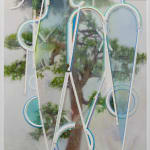
Dil Hildebrand
152.4 x 101.6 cm
Plus d'images
In paintings that mirror the scale of human figures, abstract shapes are used as a screen beyond and through which pastoral landscapes and botanical gardens are seen. These shapes swing between form and function; speaking the language of formal abstraction while simultaneously interacting with the image as architectural framing. Gate and passageway motifs are used extensively to convey trompe l’oeil effects.
One perceives a distorted version of typical greenhouse architecture: rails of white bring to mind cages and fences, separating the viewer from spaces too far away to touch. Thick passages speak directly to the visceral weight of the paint itself. Scarred surfaces on the paintings point to a restless process of manufacture; space and surface within them appear to be in physical conflict. In these fuzzy painted images we see the artist’s ongoing interest in the capacity for the materials of art to touch upon our awareness in a distinctly physical way.
_______
Le travail de Dil Hildebrand est axé sur des stratégies de dédoublement de la peinture, où la surface fonctionne comme un seuil entre l'œil du spectateur et des espaces qui semblent se situer dans les profondeurs de l'image picturale.
Dans les peintures qui reflètent l'échelle des figures humaines, des formes abstraites sont utilisées comme un écran au-delà duquel et à travers lequel des paysages pastoraux et des jardins botaniques sont vus. Ces formes oscillent entre forme et fonction ; elles parlent le langage de l'abstraction formelle tout en interagissant avec l'image en tant que cadre architectural. Les motifs de portes et de passages sont largement utilisés pour créer des effets de trompe-l'œil.
On perçoit une version déformée de l'architecture typique des serres : des rails blancs rappellent les cages et les clôtures, séparant le spectateur d'espaces trop éloignés pour être touchés. Les passages épais évoquent directement le poids viscéral de la peinture elle-même. Les surfaces cicatrisées des peintures indiquent un processus de fabrication agité ; l'espace et la surface semblent être en conflit physique. Dans ces images peintes floues, nous voyons l'intérêt continu de l'artiste pour la capacité des matériaux de l'art à toucher notre conscience d'une manière distincte.
Expositions
Future Fairs 2023 Future FairThe work of Dil Hildebrand centres on strategies of twofoldedness in painting where the surface operates as a threshold resting between the viewer’s eye and spaces that appear situated deep within the pictorial image.
In paintings that mirror the scale of human figures, abstract shapes are used as a screen beyond and through which pastoral landscapes and botanical gardens are seen. These shapes swing between form and function; speaking the language of formal abstraction while simultaneously interacting with the image as architectural framing. Gate and passageway motifs are used extensively to convey trompe l’oeil effects.
One perceives a distorted version of typical greenhouse architecture: rails of white bring to mind cages and fences, separating the viewer from spaces too far away to touch. Thick passages speak directly to the visceral weight of the paint itself. Scarred surfaces on the paintings point to a restless process of manufacture; space and surface within them appear to be in physical conflict. In these fuzzy painted images we see the artist’s ongoing interest in the capacity for the materials of art to touch upon our awareness in a distinctly physical way.
